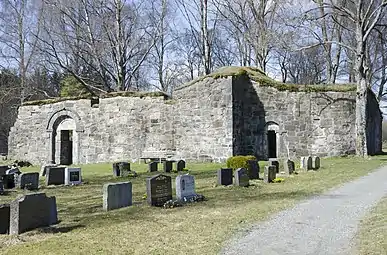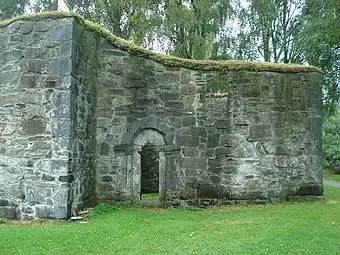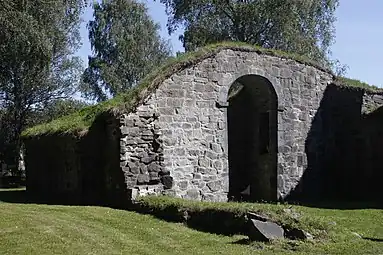| Skeidi Church / St. Olav's Church | |
|---|---|
| Skeidi kirke / Olavskirken | |
 View of the ruin of Skeidi church, a medieval church dedicated to St. Olav, inaugurated ca. 1150 | |
| 59°00′29″N 9°39′47″E / 59.008121°N 9.662982°E | |
| Location | Bamble Municipality, Vestfold og Telemark |
| Country | Norway |
| Denomination | Church of Norway |
| Previous denomination | Catholic Church |
| Churchmanship | Evangelical Lutheran |
| History | |
| Status | Parish church |
| Founded | 12th century |
| Consecrated | 4 October (year unknown) |
| Architecture | |
| Functional status | Ruins |
| Architectural type | Long church |
| Completed | c. 1150 |
| Closed | 1845 |
| Specifications | |
| Materials | Stone |
| Administration | |
| Diocese | Agder og Telemark |
| Deanery | Bamble prosti |
| Parish | Bamble |
| Type | Church |
| Status | Automatically protected |
| ID | 52378 |
St. Olav's Church or Skeidi Church (Norwegian: Olavskirken or Skeidi kirke) is a partly restored ruins of a parish church of the Church of Norway in Bamble Municipality in Vestfold og Telemark county, Norway. It is located in the village of Bamble. It was the church for the Skeidi parish which was part of the Bamble prosti (deanery) in the Diocese of Agder og Telemark. The stone church was built in a long church design around the year 1150 using plans drawn up by an unknown architect.
The church ruins are located by the European route E18 highway, about 150 metres (490 ft) to the south of the newer Bamble Church which was completed in 1845. Bamble Church was constructed in part with stone from the ruins.[1][2]
History
Skeidi Church was built of stone sometime before 1150 in Romanesque-Norman style inspired by English Norman architecture. It was dedicated to St. Olaf, the patron saint of Norway, so it was also known as St. Olav's Church. The church served as a center for the veneration of St. Olaf by the nearby Gimsøy Abbey. It has a rectangular nave measuring about 12.8 by 9 metres (42 ft × 30 ft) and narrower, rectangular chancel measuring about 5.2 by 4.1 metres (17 ft × 13 ft) with a medieval stone sacristy built on the north side of the chancel. There is some uncertainty about the end of the church to the west, so it is possible that the nave extended further than the visible end of today and that it had a west tower. In that case, it would have been the largest stone church in Telemark during that period. It had a number of unusual building features, including a chancel screen (lektorium). The church was consecrated on 4 October, but the year is unknown.[3][4]
Until 1738, the Skeidi parish comprised Sannidal, Skåtøy, Kragerø, and Bamble. The church was the main church within the district of Grenland and therefore had the highest status of all churches in the area.[5][3]
In 1814, this church served as an election church (Norwegian: valgkirke).[6][7] Together with more than 300 other parish churches across Norway, it was a polling station for elections to the 1814 Norwegian Constituent Assembly which wrote the Constitution of Norway. This was Norway's first national elections. Each church parish was a constituency that elected people called "electors" who later met together in each county to elect the representatives for the assembly that was to meet in Eidsvoll later that year.[6][8]
By 1840, the parish needed a new church and it was decided to close the old church and build a new one on a site about 150 metres (490 ft) to the north. A lot of the stone from the old church was used to build the foundation for the new church. The new Bamble Church was completed in 1845. Afterwards, the remains of the old church was left to continue to fall into ruins. Only parts of some walls remained, mostly on the south side. In the 1950s, there were plans to rebuild the entire church, but they never came to fruition. During the 1980s, an effort to restore and rebuild the small chapel in the ruins was carried out. The separate small room, which today is called Maria's Chapel (Mariakapellet), was consecrated by the Bishop Halvor Bergan on 29 July 1988. There is a regular Olsok service each year in the chapel, along with some weddings and baptisms. Since 1998, the chapel has been heated, lighted, and open to the public all year round.[3][4][9]
Media gallery
 St. Olav's Church ruins main portal, with double chevron arch and columns
St. Olav's Church ruins main portal, with double chevron arch and columns St. Olav's Church cemetery
St. Olav's Church cemetery Outer wall at St. Olav's Church ruins
Outer wall at St. Olav's Church ruins St. Olav's Church ruins
St. Olav's Church ruins Maria Chapel in St. Olav's Church ruins
Maria Chapel in St. Olav's Church ruins
See also
References
- ↑ "Bamble kirke". lokalhistoriewiki.no. Retrieved 1 September 2016.
- ↑ "Bamble kirke". Den Norske Kirke. Retrieved 1 September 2017.
- 1 2 3 "Bamble gamle kirkested - Bamble kirkeruin" (in Norwegian). Norwegian Directorate for Cultural Heritage. Retrieved 14 December 2022.
- 1 2 "Olavskirken (Bamble)". Norges-Kirker.no (in Norwegian). Retrieved 14 December 2022.
- ↑ "Olavskirken – Skeidi kirke i Bamble". miklaborg.net (in Norwegian).
- 1 2 "Valgkirkene". LokalHistorieWiki.no (in Norwegian). Retrieved 11 December 2022.
- ↑ "Valgkartet". Valgene i 1814 (in Norwegian). Arkivverket. Archived from the original on 24 June 2021. Retrieved 11 December 2022.
- ↑ "Om valgene". Valgene i 1814 (in Norwegian). Arkivverket. Retrieved 11 December 2022.
- ↑ "Messe i Olavskirken ruin i Bamble". Vår Frue Kirke (in Norwegian).
External links
- Olavskirken i Bamble (Den Norske Kirke)